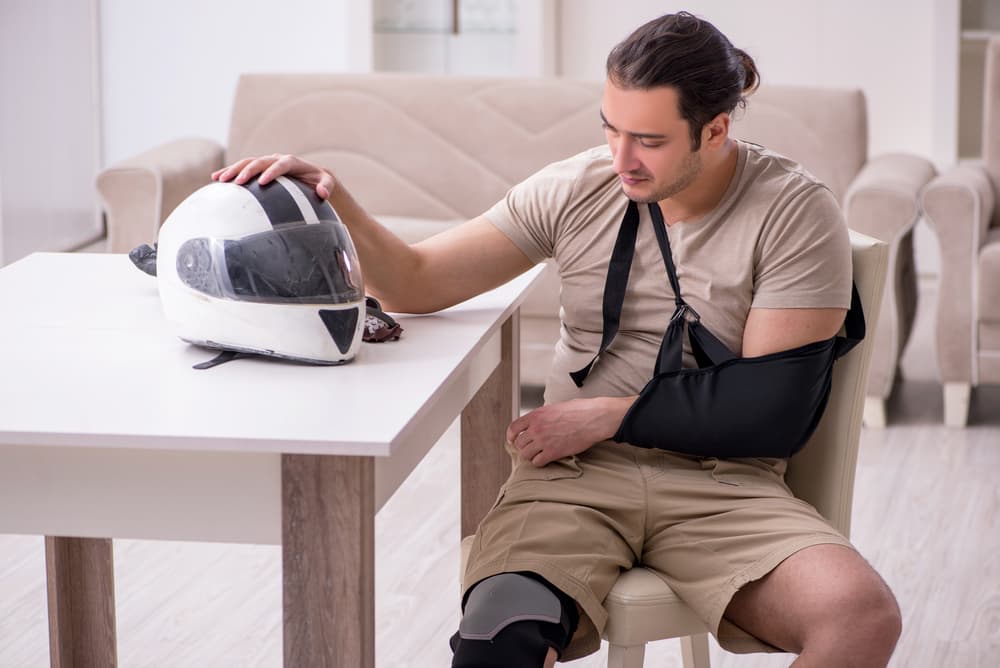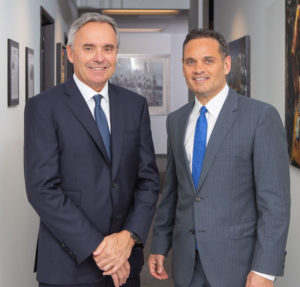How Can a Motorcycle Accident Lawyer Help You?
How Can a Motorcycle Accident Lawyer Help You?
Imagine you’re enjoying a ride when a distracted driver suddenly causes a collision. The thrill of the open road can turn into a nightmare in a flash. When such incidents occur, you need more than just gear; you need legal experts. In the chaos that follows, lawyers become your lifeline.
Lawyers play a crucial role in helping motorcycle accident victims navigate the complex aftermath. Beyond handling legal complexities, lawyers become your voice and shield against insurance companies trying to shortchange your compensation. They gather evidence, interview witnesses, and build a strong case to ensure justice prevails.
From negotiating with insurance companies to securing maximum compensation in court, motorcycle accident attorneyare the unsung heroes who restore hope and help rebuild shattered lives.
So, fasten your helmets and join us on a journey into the world of legal warriors who stand by your side when the road takes an unexpected, often treacherous, turn. Discover how these tireless advocates provide the support and justice that motorcycle accident victims need, ensuring a smoother path to recovery.
Schedule a Free Initial Consultation
The Risk of Motorcycles
Motorcycle riding in California offers pleasure and scenic beauty but comes with risks. Thus, motorcyclists must complete a training course to obtain a California motorcycle license. California requires you to wear a helmet, which prevents accidents and

traumatic brain injuries. Never ride without one.
Despite safe riding practices, accidents can still occur.
If you find yourself in an accident due to someone else’s negligence, hire a California motorcycle accident lawyer. They can work to secure a fair settlement and represent you in court.
In the world of motorcycle riding, ride responsibly, wear your helmet, and remember that a California motorcycle accident lawyer can advocate for you when needed.
Types of Motorcycle Accidents
Motorcycle accidents can take various forms, but some common types include:
- Single-vehicle accidents: These occur when a motorcycle crashes without any involvement of another vehicle. They can result from rider error, road hazards, or adverse weather conditions.
- Rear-end collisions: These accidents happen when a vehicle behind a motorcycle fails to stop and hits the motorcycle from behind. Sometimes leading to the bike throwing the rider.
- Left-turn accidents: These accidents happen when a motorcycle proceeds straight through an intersection, and a vehicle turning left fails to yield.
- Lane-changing accidents: These occur when a vehicle changes lanes and collides with a motorcycle in the adjacent lane or forces the motorcyclist off the road.
- Sideswipe accidents: These accidents involve a vehicle colliding with the side of a motorcycle, often while attempting to change lanes without noticing the motorcycle in the adjacent lane.
- Door-opening accidents: These accidents occur when a parked vehicle’s occupant opens a car door without checking for an oncoming motorcycle, resulting in a collision.
- Head-on collisions: These are among the most severe and deadly types of motorcycle accidents involving a motorcycle colliding head-on with another vehicle. They often result from a vehicle crossing the centerline or driving in the wrong direction.
Each type of motorcycle accident presents unique challenges and considerations in determining liability and assessing the extent of injuries.
Motorcyclists need to be aware of these potential scenarios and take precautions to minimize their risk on the road.
How Do Lawyers Help Motorcycle Accident Victims?
A lawyer provides valuable services to motorcycle accident victims, including:
- Legal Counsel: Advising victims on their rights, options, and the legal process after an accident.
- Investigation: Collecting evidence and interviewing witnesses to build a strong case.
- Determining Liability: Identifying fault, whether the motorcyclist, another driver, or multiple parties.
- Dealing With Insurance Companies: Negotiating fair compensation for medical expenses, property damage, lost wages, and pain and suffering.
- Filing Lawsuits: Initiating personal injury lawsuits when necessary to seek damages through the legal system.
- Legal Representation: Advocating for clients in court and presenting their case.
- Settlement Negotiation: Engaging in negotiations for a fair settlement without going to trial.
- Expert Witnesses: Consulting with accident reconstructionists, medical professionals, and other experts to support the case.
- Medical Treatment Coordination: Assisting with arranging proper medical care for the victim.
- Legal Documentation: Handling all necessary legal paperwork, including court filings and correspondence.
- Mediation or Arbitration: Recommending and participating in alternative dispute resolution methods when appropriate.
- Trial Preparation: Preparing for trial, including jury selection and evidence gathering.
- Emotional Support: Providing emotional guidance throughout the legal process.
- Maximizing Compensation: Striving to secure the maximum compensation for injuries and losses.
These services are crucial for helping motorcycle accident victims recover physically, emotionally, and financially from the aftermath of a collision.
How Do Lawyers Investigate Accident Cases?
Accident lawyers employ a systematic approach to investigate cases:
- Gather Information: Collect all available accident-related information, including the police report, witness statements, photographs, and other scene evidence.
- Review Medical Records: Obtain and review the victim’s medical records to understand injuries, treatment, and prognosis.
- Consult Experts: Depending on the accident type, lawyers may consult specialists like accident reconstruction experts, medical professionals, or engineers to analyze evidence.
- Interview Witnesses: Conduct witness interviews to reconstruct events leading to the incident and establish liability.
- Examine Evidence: Review evidence, such as photos, videos, and physical scene evidence, to determine accident causes and faults.
- Analyze Insurance Policies: Review involved parties’ insurance policies to identify compensation sources, including liability coverage, underinsured/uninsured motorist coverage, and additional policies.
- Identify Negligence: Assess negligence involvement, considering factors like distracted driving, speeding, failure to yield, and traffic law violations.
- Document Damages: Document all victim losses, including medical costs, property damage, lost wages, and pain and suffering.
- Conduct Discovery: In litigation cases, engage in the discovery process, including information and evidence exchange with the opposing party, such as depositions, interrogatories, and document requests.
- Build Case Strategy: Develop a tailored legal strategy based on findings, highlighting compelling arguments for liability, and determining appropriate compensation.
- Negotiate With Opponents: Negotiate with insurance companies or the responsible party to seek a fair settlement, presenting evidence, expert opinions, and legal arguments.
- Prepare for Trial: If neither party will consent to an agreement, prepare for trial, including jury selection, evidence organization, and persuasive case presentation.
Throughout this process, lawyers communicate closely with their clients, ensuring their interests are well-represented. The goal is constructing a strong case supporting the victim’s compensation claims.
How Do Lawyers Prove Fault?
Lawyers use strategies to prove liability in a motorcycle accident. Proving liability involves demonstrating that another party’s negligence or wrongful actions were the primary cause of the accident.

Here are some common approaches lawyers use:
- Gathering Evidence: Lawyers collect all available evidence related to the accident. This includes the police report, accident scene photographs, vehicle damage, skid marks, and road conditions.
- Eyewitness Testimonies: Lawyers interview witnesses. Eyewitnesses can provide valuable accounts of what they saw, including who they believe was at fault.
- Accident Reconstruction: In complex cases, lawyers may employ accident reconstruction experts who use scientific methods to recreate the accident and determine the likely sequence of events to help establish liability.
- Expert Witnesses: Lawyers may call upon experts in various fields, such as medical professionals, engineers, or accident reconstructionists, to testify and provide their opinions regarding the cause of the accident.
- Reviewing Traffic Laws: Lawyers will assess whether the other party violated any traffic laws or regulations in the accident. Violations can be strong indicators of negligence.
- Driver Statements: Statements made by the parties involved in the accident, especially admissions of fault, can be used as evidence in establishing liability.
- Photographs and Videos: Visual evidence, such as photos or videos taken at the scene, can help illustrate the conditions and factors contributing to the accident.
- Cell Phone Records: If distracted driving is suspected, lawyers may obtain cell phone records to demonstrate that the other party was using their phone during the accident.
- Vehicle Maintenance and Inspection: Lawyers may investigate the maintenance records and condition of the vehicles to determine if mechanical failure played a role.
- Weather and Road Conditions: Weather and road conditions at the time of the accident can be significant factors. Lawyers assess whether adverse conditions contributed to the accident.
- Witness Statements: Statements from passengers or bystanders can provide valuable insights into the sequence of events.
- Police Reports: Lawyers review the police report, statements from involved parties and witnesses, and any citations issued.
- Driver History: Lawyers may investigate the driving history of the other party involved to see if prior traffic violations or accidents suggest a pattern of negligent behavior.
- Vehicle Data Recorders (Black Boxes): Some vehicles have event data recorders (EDRs) that capture data about vehicle speed, braking, and other factors leading to an accident.
- Medical Records: If injuries are involved, lawyers may review medical records to establish a link between the accident and the damages sustained.
Lawyers collect and show this evidence to prove the other party did something wrong in a motorcycle accident. They want to make a strong case for their client. The better the evidence and legal arguments, the more it can affect the case result.
How Do Lawyers Get the Most Compensation?
Here’s how lawyers work diligently to secure the highest compensation for their clients in a motorcycle accident case:
- Thorough Case Evaluation: Lawyers begin by conducting an evaluation of the case, including assessing the extent of injuries, property damage, and other losses. This evaluation helps determine the potential value of the claim.
- Documenting Damages: Lawyers document all damages suffered by the victim, including medical bills, property damage costs, lost wages, and pain and suffering. Accurate documentation is crucial for justifying compensation demands.
- Understanding Insurance Coverage: Lawyers carefully review all insurance policies, including liability coverage, underinsured/uninsured motorist coverage, and any additional applicable policies. Your lawyer will identify all available insurance coverage to maximize your compensation.
- Negotiation Skills: Lawyers negotiate with insurance companies or the at-fault party to secure a fair settlement. Lawyers use skilled negotiation tactics to advocate for the highest possible compensation.
- Expert Witnesses: Lawyers may bring in expert witnesses, such as medical experts, accident reconstructionists, or economists, to provide professional opinions and testify about the extent of damages and their financial impact.
- Legal Research: Lawyers conduct in-depth legal research to identify relevant case law and legal precedents supporting their client’s compensation claim.
- Building a Strong Case: Lawyers compile a compelling case by gathering evidence, interviewing witnesses, and using accident reconstruction when necessary. A strong case increases the likelihood of obtaining a favorable outcome.
- Preparing for Trial: Lawyers prepare for trial if negotiations do not yield a satisfactory settlement. This includes selecting a jury, presenting evidence, and developing persuasive arguments to maximize compensation.
- Understanding Comparative Negligence: In some cases where the victim shares partial fault for the accident, lawyers work to minimize the client’s degree of responsibility, as this can affect the final compensation amount.
- Emphasizing Pain and Suffering: Lawyers highlight the physical and emotional pain and suffering experienced by the victim. This can significantly impact the compensation awarded.
- Presenting Future Damages: Lawyers consider the long-term consequences of the accident, such as ongoing medical treatment and future lost earnings, when determining compensation amounts.
- Using Demand Letters: Lawyers often send letters outlining their client’s case and the requested compensation amount to the responsible party or insurance company. This formal communication can lead to productive negotiations.
- Alternative Dispute Resolution: Lawyers may recommend mediation or arbitration as alternatives to litigation to settle more efficiently while aiming for maximum compensation.
- Appealing to Sympathy: Lawyers may humanize their client’s story and appeal to the empathy of insurance adjusters, jurors, or opposing parties to increase the chances of obtaining higher compensation.

Greg Bentley & Keith More Motorcycle Accident Attorneys
By employing these strategies and advocating tirelessly for their client’s rights, personal injury lawyers ensure motorcycle accident victims receive the highest compensation possible for their injuries and losses.
Motorcycle accidents in Orange County are serious business. Your life can turn upside down in a second. If you need help, call Bentley and More at (949) 870-3800 or contact us for a free consultation. We’ll discuss your options, potential settlement, and how to get your life back to normal.


